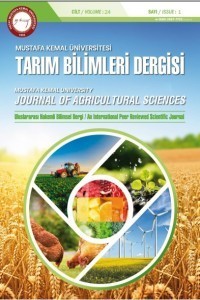Bal arısının (Apis mellifera L.) Mustafa Kemal Üniversitesi Kampüsünde bulunan bazı bitkiler üzerindeki bitki tercihi
Bal arısı, tozlaşma, bitki tercihi, çiçeklenme
Plant preference of honey bee (Apis mellifera L.) over some plants grown in Mustafa Kemal University Campus
Honey bee, pollination, plant preference, flowering,
___
- Barrow DA, Pickard RS (1984) Size-related selection of food plants by bumblebees. Ecol Entomol. 9: 369-373.
- Bell G, Lefebvre L, Giraldeau L-A, Weary D (1984) Partial preference of insects for the male flowers of an annual herb. Oecologia 64:287-294.
- Cameron DL (1981) Chemical signals in bumble bee foraging. Behav. Ecol. Sociobiol. 9: 257-260.
- Celep F, Atalay Z, Dikmen F, Doğan M, Classen-Bockhoff R (2014) Flies as pollinators of melittophilous Salvia species (Lamiacea). American Journal of Botany 101(12): 2148-2159.
- Duffield GE, Gibson RC, Gilhooly PM, Hesse AJ, Inkley CR, Gilbert FS, Barnard CJ (1993) Choice of flowers by foraging honey bees (Apis mellifera): possible morphological cues. Ecol. Entomol. 18: 191-197.
- Geslin B, Oddie M, Folschweiller M, Legras G, Seymour CL, Van-Veen FJF, Thébault E (2016) Spatiotemporal changes inflying insect abundance and theirfunctional diversity as a function of distance to natural habitats in a massfloweringcrop. Agric. Ecosyst. Environ. 229: 21–29.
- Geslin B, Aizen AM, Garcia N, Pereira AJ, Vaissière BE, Garibaldi LA (2017) The impact of honey bee colony quality on crop yield and farmers profit in apples and pears. Agriculture Ecosystems & Environment 248: 153-161.
- Giurfa M, Nunez JA (1992) Honey bees mark with scent and reject recently visited flowers. Oecologia 89: 117-123.
- Giurfa M, Nunez JA (1993) Efficient floret inspection by honey- bees in capitula of Carduus acanthoides. Ecol Entomol 18: 116-122.
- Galen C, Newport MEA (1987) Bumble bee behavior and selection on flower size in the sky pilot, Polemonium viscosum. Oecologia 74: 20-23.
- Güler A (2006) Bal arıları (Apis mellifera L.)’nda yapay tohumlama ve Türkiye için önemi. Anadolu Tarım Bilimleri Dergisi 21(3): 370-378.
- Harder LD (1988) Choice of individual flowers by bumblebees: interaction of morphology, time and energy. Behaviour 104:60-77.
- Kuvancı A, Deveci M, Alay F, Çankaya N, Avcı M (2016) Balarılarının (Apis mellifera L.) bitki tercihinde iskenderiye üçgülü (Trifolium alexandrinum L.) ve fazelya (Phacelia tanacetifolia B.)’nın yeri. Tarla Bitkileri Merkez Araştırma Enstitüsü Dergisi 25(2): 188-194.
- Kaufman PB (1989) Plants their biology and importance. Harper & Row Publishers, New York. pp 757.
- Kolreuter JG (1761) Vorläufige nachricht von einigen das geschlecht der pflanzen betreffenden versuchen und beobachtungen. Gleditsch, Leipzig. pp 267.
- Macukanovic-Jocic M, Stevanovic ZD, Mladenovic M, Jocic G (2011) Flower morphophysiology of selected Lamiaceae species in relation to pollinator attraction. Journal of Agricultural Research 50(2): 89-101.
- Ne’eman G, Dafni A (1999) Fire, bees and seed production in a mediterranean key species Salvia fruticosa Miller (Lamiaceae). Israel Journal of Plant Science 47: 157-163.
- Ollerton J, Winfree R, Tarrant S (2011) How many flowering plants are pollinated by animals? Oikos 120(3): 321-326.
- Roubik DW (1995) Pollination of cultivated plants in the tropics. FAO Agric. Serv. Bull. No:118. Rome. pp 196.
- Schmitt U, Bertsch A (1990) Do foraging bumblebees scent-mark food sources and does it matter? Oecologia 82: 137-142.
- Sprengel CK (1793) The secret of nature in the form and fertilization of flowers discovered. Friedrich Vieweg dem aeltern, Berlin.
- Waite MB (1895) Pollination of pear flowers. US Dept. Agr. Div. Veg. Path. Bull. 5 pp 86.
- Yayın Aralığı: Yılda 3 Sayı
- Başlangıç: 1996
- Yayıncı: Hatay Mustafa Kemal Üniversitesi
RapidEye ve PlanetScope uydu bantları ile pamuk bitkisi yaprak azot içeriğinin belirlenmesi
Serkan KILIÇASLAN, Remzi EKİNCİ, Sema BAŞBAĞ
İlker Ahmet SEFEROĞLU, Nihat DEMİREL
Bazı fiğ türlerinin yem verim ve kalitesi üzerine farklı organik gübrelerin etkileri
İbrahim ERTEKİN, İbrahim ATIŞ, Şaban YILMAZ
Serkan URANBEY, Güray AKDOGAN, Hussein Abdullah Ahmed AHMED, Mikail CALİSKAN
Ayşe Alev AVŞAR, Gülşen ÇOPUR AKPINAR
Sinop Karasu Çayı fizikokimyasal özellikleri ve mikrobiyolojik kirliliğinin araştırılması
Çeltik üretiminde suyun etkili kullanımında toprakaltı damla sulama ve su tutma bariyeri kullanımı
Kürşad DEMİREL, Gökhan ÇAMOĞLU, Özgür TATAR, Hakan NAR, Ahmet BORAN, İlker EROĞLU, Levent GENÇ
